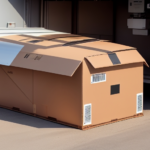The Benefits of Scheduling Delivery for Your Business
As businesses continue to grow and expand their reach, managing logistics becomes increasingly challenging. One significant pain point involves managing and scheduling deliveries. In the past, businesses relied on quick communication methods like phone calls or emails to coordinate deliveries, often leading to errors and delays. Nowadays, businesses are turning to scheduled deliveries—a process that optimizes time, effort, and cost. This article discusses the benefits of scheduling delivery and how it can help your business achieve its goals.
Importance of Scheduling Deliveries for Business Success
Scheduling deliveries is critical for business success, irrespective of the nature of the business. When the shipment of goods or materials is mishandled, it can lead to significant financial losses, damage to reputation, and even legal consequences. Efficient reporting tools provide a visual representation of deliveries in an organized manner, enabling dispatchers to manage and oversee them effectively. Moreover, scheduled deliveries cater to customer convenience by allowing them to choose the delivery time, date, or location, thereby fostering a consumer-friendly environment.
In addition, scheduling deliveries allows businesses to optimize their resources. By planning ahead, companies can ensure they have the necessary staff, vehicles, and equipment to handle deliveries, reducing costs and increasing efficiency by eliminating last-minute scrambling for resources.
Furthermore, scheduled deliveries help businesses reduce their carbon footprint. By planning routes and consolidating deliveries, companies can minimize the number of vehicles on the road, thereby reducing emissions and traffic congestion. This not only benefits the environment but also helps businesses save on fuel costs and enhance their reputation as socially responsible entities.
According to a report by McKinsey & Company, efficient logistics scheduling can reduce transportation costs by up to 20% while improving delivery times.
Enhancing Customer Satisfaction through Scheduled Deliveries
Timely delivery of goods and catering to customer convenience have a profound impact on customer satisfaction. Scheduled deliveries enable businesses to offer delivery options that align with the customer's lifestyle, schedule, and location, enhancing their overall experience. Additionally, timely delivery mitigates the risk of customer dissatisfaction, ensuring that customers are satisfied with both the service and the products they receive.
Moreover, scheduled deliveries help businesses optimize their operations and reduce costs. By planning and organizing deliveries in advance, businesses can streamline their logistics and reduce the number of trips required, saving time and money. This efficiency also leads to a reduced carbon footprint, contributing to a more environmentally friendly operation.
Businesses that offer personalized delivery options and keep customers informed about the status of their deliveries can build stronger customer relationships. This creates a sense of trust and reliability, leading to increased customer loyalty, repeat business, and positive word-of-mouth recommendations.
Maximizing Efficiency and Profitability with Scheduled Deliveries
Scheduling deliveries optimizes time management and enhances business efficiency. By planning pickup and delivery routes meticulously, businesses can minimize transportation costs and reduce time spent on the road. Scheduled deliveries also introduce a level of predictability in dispatching and driver management, allowing businesses to allocate and manage resources effectively, ultimately boosting profitability.
In addition to these benefits, scheduled deliveries improve customer satisfaction by providing reliable and consistent delivery schedules. This reliability helps build trust with customers, fostering loyalty and driving repeat business and positive referrals. Furthermore, scheduled deliveries enable businesses to meet tight deadlines and ensure timely delivery of goods, which is crucial in industries like healthcare and manufacturing.
According to the Supply Chain Digital, businesses that implement scheduled deliveries see a significant increase in operational efficiency and customer satisfaction rates.
Integrating Technology to Streamline Delivery Scheduling
Incorporating technology into delivery scheduling can significantly streamline the process by automating many inefficient manual tasks. With real-time updates and notifications, businesses can receive instant updates on shipment status, route information, and other critical details. The integration of remote and mobile technologies allows dispatchers to manage operations efficiently, reducing the need for intermediaries and simplifying the process.
One of the most significant advantages of using technology for delivery scheduling is the ability to track and analyze data. By collecting and analyzing data, businesses can identify patterns and trends in delivery times, routes, and other factors influencing operational efficiency. This information can be used to make data-driven decisions that further streamline the delivery process and enhance overall performance.
Tools like Oracle's Delivery Management and SAP Delivery Management offer comprehensive solutions for monitoring and optimizing delivery schedules.
Best Practices for Implementing Scheduled Deliveries
Implementing scheduled deliveries can significantly improve logistics operations, but it requires careful planning and execution. Businesses should start by evaluating their current delivery processes, identifying strengths and weaknesses, and mapping out the logistics landscape. Leveraging technology solutions is crucial to enhance workflow, alongside providing proper employee training to ensure successful implementation.
- Evaluate Current Processes: Assess the strengths and weaknesses of your existing delivery system.
- Leverage Technology: Utilize delivery management software to streamline scheduling and tracking.
- Train Employees: Ensure that your team is well-equipped and trained to handle the new scheduling processes.
- Communicate Clearly: Establish clear communication channels with customers regarding delivery times and statuses.
- Continuous Improvement: Regularly review and analyze delivery processes to identify and implement improvements.
Establishing clear communication channels with customers is also vital. This includes providing accurate delivery times, tracking information, and updates in case of delays or changes, which helps build trust and loyalty with customers, leading to increased satisfaction and repeat business.
Regularly reviewing and analyzing the scheduled delivery process is essential to identify areas for improvement, such as optimizing routes, analyzing delivery times, and addressing bottlenecks or inefficiencies. Continuous improvement ensures that businesses provide the best possible service while maximizing efficiency and profitability.
Future Trends in Delivery Scheduling
The landscape of delivery scheduling is evolving with emerging technologies and trends. Innovations such as artificial intelligence, the Internet of Things (IoT), and automated vehicles are set to transform delivery scheduling practices. AI-powered systems can predict demand patterns and optimize delivery routes in real-time, while IoT devices enable better tracking and monitoring of shipments.
Automated vehicles and drones are anticipated to play a significant role in the future of delivery, reducing human error and increasing efficiency. Businesses that adopt these technologies early can position themselves as industry leaders, gaining a competitive edge in the market.
Staying abreast of these trends and integrating relevant technologies will be crucial for businesses aiming to enhance their delivery scheduling processes and maintain competitiveness.
Further insights can be found in the Forbes Technology Council's article on future trends.
In conclusion, scheduled deliveries offer numerous benefits that help businesses streamline operations, enhance efficiency, improve customer service, and ultimately increase profitability. With the advancement of technology and continuous innovations, scheduled deliveries present a practical approach to logistics management. Businesses that effectively implement this process can gain a competitive advantage by offering superior delivery services, making it a worthwhile investment in their operations.






















